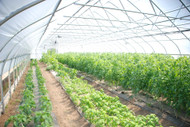Carrots can take the cold, but tomatoes like it hot. The question is: how do you provide for both in the course of one year?
With the right greenhouse and the right knowledge, you can make your grow space the perfect place to bring up just about any kind of crop - and even improve the output of the ones you’ve grown for years.
When it comes to bringing up your best crops in your greenhouse, few factors make more of a difference toward your overall yield than proper environmental control. But keeping your greenhouse at the perfect conditions for your plants can be tricky - especially if you’re not sure what to control for.
Here’s a look at some of the most important environmental factors influencing the crops in your greenhouse, and what you can do to make sure your plants have the perfect environment to pump out the best harvest yet.
The Four Factors of Greenhouse Environmental Control
As any scientist will tell you, a growing environment is more than just the temperature of the air outside. It’s a full combination of many factors that influence plant growth - the main four being heat, humidity, light levels, and ventilation.
By knowing each of these factors and taking control of each individually, you stand a better chance of providing exactly the right combination - or “environment” - for your plants to succeed better than ever before.
Heat
Some crops simply can’t take the heat; others might love things a little toasty. Thanks to new greenhouse technologies, delivering the perfect temperature for your fruits, veggies, leafy greens, and flowers has never been easier.
Ask just about any greenhouse grower in areas with colder temperatures where the warmest spot on their field is and they’ll likely point you right inside the greenhouse itself. As plants “breathe” CO2 and exert oxygen, they also produce heat - a warm, damp heat that can build up quickly if left unaddressed. This heat buildup can have the effect of actually helping the growth of warmth-loving crops like tomatoes, peppers, peas, and avocado, and can act as a natural heating source to insulate your plants when the weather outside your greenhouse is a bit chilly.
Likewise, greenhouse temperature controls help you to lower the temperature in your greenhouse during those hot summer months, when an excess of heat can actually lead to heat stress and other high-temperature diseases that can damage your output. Shade coverings, sun-resistant poly, and good ventilation can all help lower your greenhouse’s internal temperature to keep plants at the right temperature for success.
Humidity
Also highly important for crop success - and often deeply tied to temperature - is humidity, which can have a profound effect on the conditions within your greenhouse if left uncontrolled.
Long left up to nature on outdoor fields and highly variable with rain or drought conditions, humidity now plays a key role in environmental controls within greenhouses. That’s because plants naturally expel warm, moist oxygen into the air as they grow and process CO2, making your greenhouse naturally warmer and moisture over time.
While some plants may thrive in a slightly moist environment (think: cucumbers, tomatoes, and other water-rich veggies), the presence of too much moisture can encourage the growth of nasty molds and even harbor diseases or pests, all of which can do irreparable damage to your crops without much warning.
With a combination of proper ventilation and heat management, you can carefully monitor and control humidity in your greenhouse to make sure everything is right where it should be to minimize mold growth while maximizing plant growth.
Ventilation
For growers working out on the windy plains of the midwest or in the dry, still deserts of the southeast, ventilation has long been simply an uncontrollable factor of outdoor growing. Thanks to advances in greenhouse technology, however, growers can now take full control of their ventilation efforts - meaning you no longer have to wait for just the right breeze to come along to keep your plants growing strong.
Ventilation plays a huge role in everything from temperature regulation to humidity mitigation, and regular airflow itself can actually be crucial to providing fresh CO2 so indoor plants can keep breathing easy.
For most modern growers, proper ventilation can be achieved through a combination of fans and vents built right into the wall of your greenhouse. By encouraging airflow on still days and closing up gaps to prevent airflow on windy days, you can more naturally regulate temperature, introduce or remove humidity, and keep plants well supplied with breathable CO2 to keep them growing strong all year long.
Sunlight
Though sunlight has long been well outside the control of growers operating in open fields under the bare sun, the ability to choose your greenhouse covering to regulate sunlight levels - and even filter out UV radiation while keeping light levels high - has had an enormous impact on growers across the world looking to extend their growing seasons.
Nearly every grower knows that some plants prefer full sun while other like a bit of shade, but never before has a grower been so easily able to provide both of these options on the same patch of land.
By utilizing tools like energy curtains, shade coverings, black-out curtains, and UV-filtering poly or plastic coverings, growers can fine tune their plants’ light diet with unparalleled levels of control.
Make It Easy (and Consistent) With Automation
Even with decades of technological experience now bringing environmental controls into the hands of your average grower, the process of actually learning how to use these tools effectively takes time, effort, and a lot of learning.
Fortunately, automatic controls now exist to take much of that burden - as well as much of the challenge - off of growers and onto highly precise, reliable, and controllable computer systems.
Automatic environmental controls can be fully integrated into all parts of your greenhouse system, controlling everything from ventilation to light curtains to humidity systems and more. By consistently monitoring interior greenhouse conditions and adjusting on-the-fly, your automated system can keep your greenhouse perfectly attuned to the needs of your plants without the need for constant monitoring and adjusting.
And since many automated environmental control systems feature easy mobile phone integration, growers can keep a close watch on their greenhouse at all times for up-to-date readings of humidity, heat, and light levels inside their greenhouse structures.
Ready To Take Control Of Your Grow Space?
For growers looking to ensure total control of their greenhouse growing environment, there has never been technology more exciting (or with more opportunity) than modern environmental control systems.
If you’re looking for a way to improve your grow while maximizing the productivity of your greenhouse, get in touch and let’s discuss the right environmental control systems for your greenhouse. Your plants - and your next harvest - may just thank you for it.
Together, We Grow!

